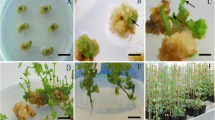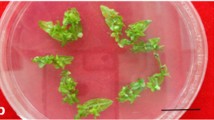Abstract
The chromosome number of cells in the shoot primordium aggregates and produced plants of melon [Cucumis melo L. 'Prince' (2n=2x=24)] was examined. Shoot primordium aggregates were induced from shoot-tips cultured in liquid medium and shaken at low speed (2 rpm). They were maintained by subculturing small pieces (5mm<) every 4 weeks. Shoot primordium aggregates just after induction contained about 97 diploid and 3 tetraploid cells, which was similar to those maintained in shoot primordium cultures for 6 years. This indicates that the ploidy level was maintained stably. On the other hand, plants produced from the shoot primordium aggregates just after induction were either diploid, tetraploid or mixoploid with both diploid and tetraploid cells. These ploidies were again observed among plants produced from shoot primordium cultures that were 2, 3 or 4 years old. A majority of produced plants were diploid while the total frequency of tetraploids and mixoploids was less than 8 of plants produced from all ages. Therefore, the frequency of somaclonal variation with respect to ploidy among plants produced from shoot primordium aggregates is likely to be stable at a low level over the long term.
Similar content being viewed by others
References
Aitken-Christie J, Singh AP & Davies H (1988) Multiplication of meristematic tissue: a new tissue culture system for radiata pine. In Genetic Manipulation of Woody Plants: Hanover JW & Keathley DE (eds), Plenum Press, New York, London (pp 413–432)
Adelberg JW, Rhodes & Skorupska HT (1993) Generating tetraploid melons from tissue culture. Acta Hort. 336: 373–380
Adelberg JW & Rhodes BB (1994) Explant origin affects the frequency of tetraploid plants from tissue cultures of melon. HortSci. 29: 689–692
Ezura H, Amagai H, Yoshioka K & Oosawa K (1992a) Highly frequent appearance of tetraploidy in regenerated plants, a universal phenomenon, in tissue cultures of melon (Cucumis melon L.). Plant Sci. 85: 209–213
Ezura H, Amagai H, Yoshioka K & Oosawa K (1992b) Efficient production of tetraploid melon (Cucumis melo L.) by somatic embryogenesis. Jpn. J. Breed. 42: 137–144
Ezura H, Amagai H & Oosawa K (1993) Efficient production of triploid melon plants by in vitro culture of abnormal embryos excised from dried seeds of diploid x tetraploid crosses and their characteristics. Jpn. J. Breed. 43: 193–199
Ezura H & Oosawa K (1994) Selective regeneration of plants from diploid and tetraploid cells in adventitious shoot cultures of melon (Cucumis melo L.). Plant Tissue Cult. Lett. 11: 26–33
Ezura H, Kikuta I, Oosawa K (1994) Production of aneuploid melon plants following in vitro culture of seeds from a triploid x diploid cross. Plant Cell Tiss. Org. Cult. 38: 61–63
Fassuliotis G & Nelson BV (1992) Regeneration of tetraploid muskmelon cotyledon and their morphological difference for two diploid muskmelon genotypes. J. Amer. Soc. Hort. Sci. 117: 863–866.
Fujishige I, Tanaka R & Taniguchi K (1996) Efficient isolation of non-chimeric tetraploids artificially induced in a stable culture of Haplopappus gracilis. Theor. Appl. Genet. 92: 157–162
Moreno V & Roig LA (1990) Somaclonal variation in Cucurbits. In: Bajaj YSP(ed) Biotechnology in Agriculture and Forestry, Vol 11: Somaclonal Variation and Crop Improvement. Springer-Verlag, Berlin, Germany (pp 435–464)
Murashige T & Skoog F (1962) A revised medium for rapid growth and bioassays with tobacco tissue cultures. Physiol. Plant. 15: 473–479
Nagai T, Nomura Y & Oosawa K(1989) Induction of shoot primordia in melon. J. Jpn. Soc. Hort. Sci. 58(suppl.1): 208–209
Nugent PE & Ray DT (1992) Spontaneous tetraploid melons. HortSci. 27: 47–50
Shimonishi K, Nagai T, Nomura Y, Yoshioka K & Oosawa K (1993) Induction of melon shoot primordia and maintenance of their high regeneration potential. Plant Tissue Cult. Lett. 10: 17–24
Tanaka R & Ikeda H (1983) Perennial maintenance of annual Haplopappus gracilis (2n=4) by shoot tip cloning. Jpn. J. Genet. 58: 65–70
Tanaka R, Taniguchi K & Fujishige I (1988) Artificial induction of clonal tetraploids in an annual plant, Haplopappus gracilis (2n=4), by using tissue cultured shoot primordia. Jpn. J. Genet. 63: 113–125
Taniguchi K, Tanaka R, Ashitani N & Miyagawa H (1988) Freeze preservation of tissue-cultured shoot primordia of the annual Haplopappus gracilis (2n=4). Jpn. J. Genet. 63: 267–272
Wakizuka T & Yamaguchi T (1987) The induction of enlarged apical domes in vitro and multi-shoot formation from finger millet. Ann. Bot. 60: 331–336
Author information
Authors and Affiliations
Rights and permissions
About this article
Cite this article
Ezura, H., Kikuta, I. & Oosawa, K. Long-term ploidy stability of shoot primordium cultures and produced plants of melon. Plant Cell, Tissue and Organ Culture 48, 31–35 (1997). https://doi.org/10.1023/A:1005854523278
Issue Date:
DOI: https://doi.org/10.1023/A:1005854523278




